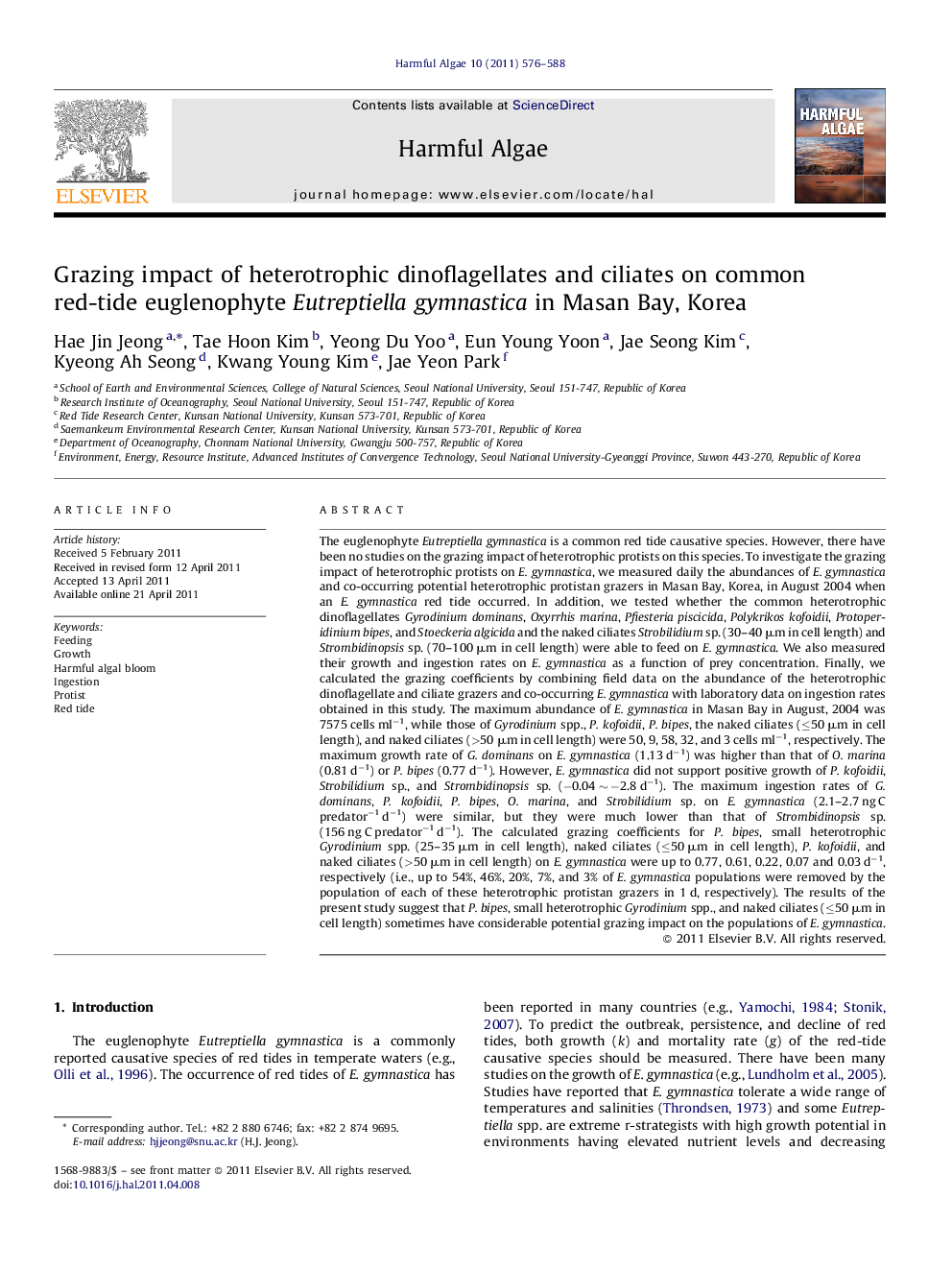| کد مقاله | کد نشریه | سال انتشار | مقاله انگلیسی | نسخه تمام متن |
|---|---|---|---|---|
| 4545672 | 1626960 | 2011 | 13 صفحه PDF | دانلود رایگان |

The euglenophyte Eutreptiella gymnastica is a common red tide causative species. However, there have been no studies on the grazing impact of heterotrophic protists on this species. To investigate the grazing impact of heterotrophic protists on E. gymnastica, we measured daily the abundances of E. gymnastica and co-occurring potential heterotrophic protistan grazers in Masan Bay, Korea, in August 2004 when an E. gymnastica red tide occurred. In addition, we tested whether the common heterotrophic dinoflagellates Gyrodinium dominans, Oxyrrhis marina, Pfiesteria piscicida, Polykrikos kofoidii, Protoperidinium bipes, and Stoeckeria algicida and the naked ciliates Strobilidium sp. (30–40 μm in cell length) and Strombidinopsis sp. (70–100 μm in cell length) were able to feed on E. gymnastica. We also measured their growth and ingestion rates on E. gymnastica as a function of prey concentration. Finally, we calculated the grazing coefficients by combining field data on the abundance of the heterotrophic dinoflagellate and ciliate grazers and co-occurring E. gymnastica with laboratory data on ingestion rates obtained in this study. The maximum abundance of E. gymnastica in Masan Bay in August, 2004 was 7575 cells ml−1, while those of Gyrodinium spp., P. kofoidii, P. bipes, the naked ciliates (≤50 μm in cell length), and naked ciliates (>50 μm in cell length) were 50, 9, 58, 32, and 3 cells ml−1, respectively. The maximum growth rate of G. dominans on E. gymnastica (1.13 d−1) was higher than that of O. marina (0.81 d−1) or P. bipes (0.77 d−1). However, E. gymnastica did not support positive growth of P. kofoidii, Strobilidium sp., and Strombidinopsis sp. (−0.04 ∼ −2.8 d−1). The maximum ingestion rates of G. dominans, P. kofoidii, P. bipes, O. marina, and Strobilidium sp. on E. gymnastica (2.1–2.7 ng C predator−1 d−1) were similar, but they were much lower than that of Strombidinopsis sp. (156 ng C predator−1 d−1). The calculated grazing coefficients for P. bipes, small heterotrophic Gyrodinium spp. (25–35 μm in cell length), naked ciliates (≤50 μm in cell length), P. kofoidii, and naked ciliates (>50 μm in cell length) on E. gymnastica were up to 0.77, 0.61, 0.22, 0.07 and 0.03 d−1, respectively (i.e., up to 54%, 46%, 20%, 7%, and 3% of E. gymnastica populations were removed by the population of each of these heterotrophic protistan grazers in 1 d, respectively). The results of the present study suggest that P. bipes, small heterotrophic Gyrodinium spp., and naked ciliates (≤50 μm in cell length) sometimes have considerable potential grazing impact on the populations of E. gymnastica.
► During the red tide dominated by the euglenophyte Eutreptiella gymnastica in Masan Bay in August 2004, the heterotrophic dinoflagellates Gyrodinium spp., Polykrikos kofoidii, Protoperidinium bipes, and the naked ciliates (≤50 μm in cell length) were abundant.
► E. gymnastica supported positive growth of G. dominans, Oxyrrhis marina, and P. bipes, but it did not support positive growth of P. kofoidii, Strobilidium sp., and Strombidinopsis sp.
► The calculated grazing coefficients for P. bipes, small heterotrophic Gyrodinium spp. (25–35 μm in cell length), naked ciliates (≤50 μm in cell length) were considerably high (0.77, 0.61, and 0.22 d−1, respectively), whereas those of P. kofoidii and naked ciliates (>50 μm in cell length) were low (0.07 and 0.03 d−1, respectively).
► P. bipes, small heterotrophic Gyrodinium spp., and naked ciliates (≤50 μm in cell length) sometimes have considerable potential grazing impact on the populations of E. gymnastica in Masan Bay.
Journal: Harmful Algae - Volume 10, Issue 6, September 2011, Pages 576–588